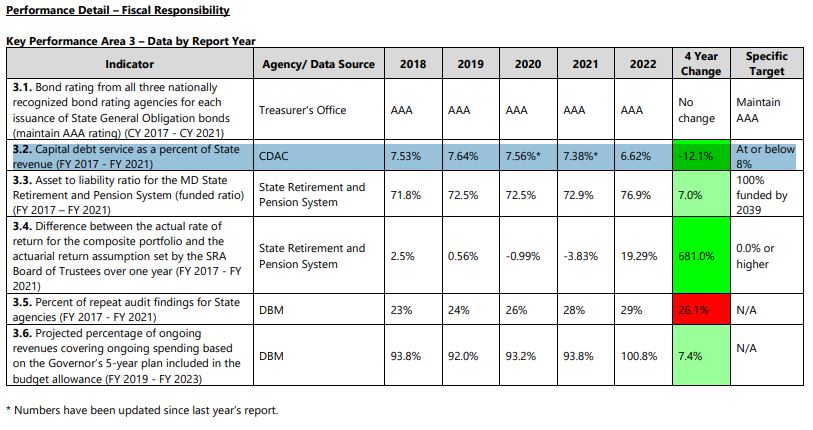Massachusetts Needs a Comprehensive Performance Management Framework
Many states have made tremendous progress toward government efficiency and effectiveness by setting goals and tracking their progress. Massachusetts tried making a performance structure, but in 2014 it was discontinued. Today, the state lacks a comprehensive structure to track progress.
What Happened to MassGOALS and Mass Results?
From around 2007 to 2014, the Deval Patrick administration worked to establish a program called Massachusetts Government Outcomes to Achieve Long-Term Success (MassGOALS) that identified nine “result areas” on which the governor wanted to make progress. The administration identified at least three measures of success for each, and even identified offices and secretaries that were accountable for results.
The management goals would have put Massachusetts in line with contemporary management practices and made the government’s goals and progress accessible to all. They even published a website called MassResults (see figure 1) that a Pioneer Institute intern at the time called “a step forward in promoting transparency in state government” (Wenli Fei).
The Patrick administration did require that state agencies each establish a performance management agenda every two years, and today state law requires annual performance assessments. The internal agendas and performance assessments created by each agency independently are the public’s best resource for state government management information.

Figure 1: The MassResults website from 2014 accessible through the wayback machine. By 2015, the website was no longer available. This site could have been the start of a performance management initiative, but was discontinued.
Today, it is not entirely clear why MassGOALS and the MassResults website were discontinued, but it is likely because of the change in leadership from Governor Patrick to Governor Baker. The next governor would be wise to reestablish the program or start a new comprehensive management system.
What is Happening Elsewhere?
Other states and the federal government have established systems that Massachusetts should use as a model if it were to establish (or re-establish) its own system.
Federal performance management started with President Bill Clinton in 1993, when he established the National Performance Review. Today, performance.gov provides the public with an interactive dashboard to view the goals and objectives of every department and agency.
At the state level, Maryland is a state that has integrated performance metrics into the operations of the state government. They established a state comprehensive plan in 2009 that guides an annual performance assessment. The assessment outlines the broad goals of the government like “fiscal responsibility” and tracks each goal using indicators like “capital debt service as a percentage of state revenue.” Anyone with an internet connection can, therefore, see that Maryland decreased its capital debt service by 12 percent over the past four years and received a green rating on that specific performance indicator (see figure 2).

Figure 2: A table taken directly from Maryland’s Managing For Results Annual Performance Report, January 2022. The table shows each of the 6 indicators that Maryland uses to track the progress of their “fiscal responsibility” goal.
Other states, like New Mexico, have introduced measures for performance budgeting. Performance budgeting is when a government incorporates performance metrics into the budget document and calculates the approximate cost of services delivered. New Mexico is a state that uses performance measures in its official budget.
One performance measure used by New Mexico, for example, is the “percent of completed tax credit applications reviewed within thirty days of receipt.” This measure specifies a desired outcome of 90 percent which would be an improvement over their 88 percent outcome in FY2021.
There are still other states that have taken similar measures like Colorado’s Dashboard, Utah’s Dashboard, Results Washington, and the Indiana Management Performance Hub (among many others).
Recommendations for Massachusetts
Massachusetts needs to reinstate a comprehensive system of performance management. Establishing it would increase accountability and transparency. A well-constructed goal-oriented framework and a system of objective performance measures would show the people of Massachusetts the impact (or lack thereof) of their taxpayer dollars. With that said, here are some recommendations for the next governor and the state legislature to get performance management where it should be in Massachusetts:
RECOMMENDATION 1: The next Governor should establish a set of government-wide cross-agency priorities.
RECOMMENDATION 2: The next governor should require departments and agencies to align their performance plans with the government-wide priorities.
RECOMMENDATION 3: Leaders of state agencies should identify sets of objective performance measures for each priority to track the state’s progress. Massachusetts could improve over other states by including calculated metrics like the cost of snow removal per mile of roadway plowed, for example.
RECOMMENDATION 4: The next governor should establish an online dashboard that brings together every agency’s performance priorities into one digital interface. This should be similar to performance.gov or performance.utah.gov.
RECOMMENDATION 5: The state legislature should make budget line items more aligned with outcomes. For example, there is only one major line item in the budget for transportation (excluding the MBTA). This could be broken down by types of expense including “ferry boats,” “highways,” and “EV subsidies.”
RECOMMENDATION 6: The next governor should assign accountability for results to specific public administrators by name. NASA’s “Volume of Integrated Performance” uses this strategy to establish accountability. Figure 3 shows that Toni Mumford is in charge of developing “a human spaceflight economy enabled by a commercial market.”

Figure 3: A section from the United States National Aeronautics and Space Administration (NASA) FY2023 Volume of Integrated Performance. This figure shows the structure of the first page for each strategic objective in the NASA performance plan. The structure includes a “lead office,” a “goal leader,” a description, and a short budget summary. The structure is a model for accountability because it identifies the exact individual and office responsible for the desired results.
Adopting these six recommendations will help state government meet the standard set by the federal government and other states. It will improve accountability, transparency, and efficiency, allowing Massachusetts to achieve more with every taxpayer dollar spent.
I have to thank Mr. John Kamensky for teaching the class that inspired this piece and for providing feedback when I was drafting this blog post!
About the Author: Joseph Staruski is a government transparency intern with the Pioneer Institute. He is currently a Master of Public Policy Student at the University of Massachusetts, Amherst. He was previously an opinions columnist with the Boston College student newspaper, The Heights, and an Intern with the Philadelphia Public School Notebook. He has a BA in Philosophy and the Growth and Structure of Cities from Haverford College. Feel free to reach out via email, LinkedIn, or write a letter to Pioneer’s Office in Boston.



